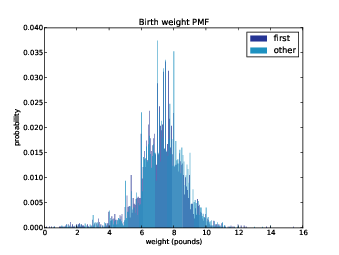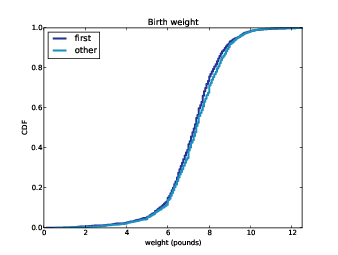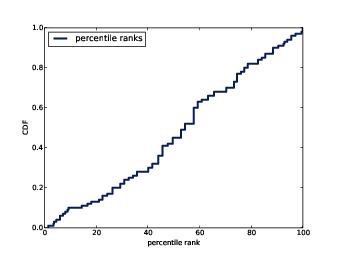This HTML version of "Think Stats 2e" is provided for convenience, but it is not the best format for the book. In particular, some of the math symbols are not rendered correctly.
You might prefer to read the PDF version, or you can buy a hard copy from Amazon.
Chapter 4 Cumulative distribution functions
The code for this chapter is in cumulative.py.
For information about downloading and
working with this code, see Section ??.
4.1 The limits of PMFs
PMFs work well if the number of values is small. But as the number of values increases, the probability associated with each value gets smaller and the effect of random noise increases.
For example, we might be interested in the distribution of birth
weights. In the NSFG data, the variable totalwgt_lb records
weight at birth in pounds. Figure ?? shows
the PMF of these values for first babies and others.
Figure 4.1: PMF of birth weights. This figure shows a limitation of PMFs: they are hard to compare visually.
Overall, these distributions resemble the bell shape of a normal distribution, with many values near the mean and a few values much higher and lower.
But parts of this figure are hard to interpret. There are many spikes and valleys, and some apparent differences between the distributions. It is hard to tell which of these features are meaningful. Also, it is hard to see overall patterns; for example, which distribution do you think has the higher mean?
These problems can be mitigated by binning the data; that is, dividing the range of values into non-overlapping intervals and counting the number of values in each bin. Binning can be useful, but it is tricky to get the size of the bins right. If they are big enough to smooth out noise, they might also smooth out useful information.
An alternative that avoids these problems is the cumulative distribution function (CDF), which is the subject of this chapter. But before I can explain CDFs, I have to explain percentiles.
4.2 Percentiles
If you have taken a standardized test, you probably got your results in the form of a raw score and a percentile rank. In this context, the percentile rank is the fraction of people who scored lower than you (or the same). So if you are “in the 90th percentile,” you did as well as or better than 90% of the people who took the exam.
Here’s how you could compute the percentile rank of a value,
your_score, relative to the values in the sequence scores:
def PercentileRank(scores, your_score):
count = 0
for score in scores:
if score <= your_score:
count += 1
percentile_rank = 100.0 * count / len(scores)
return percentile_rank
As an example, if the
scores in the sequence were 55, 66, 77, 88 and 99, and you got the 88,
then your percentile rank would be 100 * 4 / 5 which is 80.
If you are given a value, it is easy to find its percentile rank; going the other way is slightly harder. If you are given a percentile rank and you want to find the corresponding value, one option is to sort the values and search for the one you want:
def Percentile(scores, percentile_rank):
scores.sort()
for score in scores:
if PercentileRank(scores, score) >= percentile_rank:
return score
The result of this calculation is a percentile. For example, the 50th percentile is the value with percentile rank 50. In the distribution of exam scores, the 50th percentile is 77.
This implementation of Percentile is not efficient. A
better approach is to use the percentile rank to compute the index of
the corresponding percentile:
def Percentile2(scores, percentile_rank):
scores.sort()
index = percentile_rank * (len(scores)-1) // 100
return scores[index]
The difference between “percentile” and “percentile rank” can
be confusing, and people do not always use the terms precisely.
To summarize, PercentileRank takes a value and computes
its percentile rank in a set of values; Percentile takes
a percentile rank and computes the corresponding value.
4.3 CDFs
Now that we understand percentiles and percentile ranks, we are ready to tackle the cumulative distribution function (CDF). The CDF is the function that maps from a value to its percentile rank.
The CDF is a function of x, where x is any value that might appear in the distribution. To evaluate CDF(x) for a particular value of x, we compute the fraction of values in the distribution less than or equal to x.
Here’s what that looks like as a function that takes a sequence,
sample, and a value, x:
def EvalCdf(sample, x):
count = 0.0
for value in sample:
if value <= x:
count += 1
prob = count / len(sample)
return prob
This function is almost identical to PercentileRank, except that
the result is a probability in the range 0–1 rather than a
percentile rank in the range 0–100.
As an example, suppose we collect a sample with the values
[1, 2, 2, 3, 5]. Here are some values from its CDF:
| CDF(0) = 0 |
| CDF(1) = 0.2 |
| CDF(2) = 0.6 |
| CDF(3) = 0.8 |
| CDF(4) = 0.8 |
| CDF(5) = 1 |
We can evaluate the CDF for any value of x, not just values that appear in the sample. If x is less than the smallest value in the sample, CDF(x) is 0. If x is greater than the largest value, CDF(x) is 1.
Figure 4.2: Example of a CDF.
Figure ?? is a graphical representation of this CDF. The CDF of a sample is a step function.
4.4 Representing CDFs
thinkstats2 provides a class named Cdf that represents
CDFs. The fundamental methods Cdf provides are:
Prob(x): Given a valuex, computes the probability p = CDF(x). The bracket operator is equivalent toProb.Value(p): Given a probabilityp, computes the corresponding value,x; that is, the inverse CDF ofp.
Figure 4.3: CDF of pregnancy length.
The Cdf constructor can take as an argument a list of values, a pandas Series, a Hist, Pmf, or another Cdf. The following code makes a Cdf for the distribution of pregnancy lengths in the NSFG:
live, firsts, others = first.MakeFrames()
cdf = thinkstats2.Cdf(live.prglngth, label='prglngth')
thinkplot provides a function named Cdf that
plots Cdfs as lines:
thinkplot.Cdf(cdf)
thinkplot.Show(xlabel='weeks', ylabel='CDF')
Figure ?? shows the result. One way to read a CDF is to look up percentiles. For example, it looks like about 10% of pregnancies are shorter than 36 weeks, and about 90% are shorter than 41 weeks. The CDF also provides a visual representation of the shape of the distribution. Common values appear as steep or vertical sections of the CDF; in this example, the mode at 39 weeks is apparent. There are few values below 30 weeks, so the CDF in this range is flat.
It takes some time to get used to CDFs, but once you do, I think you will find that they show more information, more clearly, than PMFs.
4.5 Comparing CDFs
CDFs are especially useful for comparing distributions. For example, here is the code that plots the CDF of birth weight for first babies and others.
first_cdf = thinkstats2.Cdf(firsts.totalwgt_lb, label='first')
other_cdf = thinkstats2.Cdf(others.totalwgt_lb, label='other')
thinkplot.PrePlot(2)
thinkplot.Cdfs([first_cdf, other_cdf])
thinkplot.Show(xlabel='weight (pounds)', ylabel='CDF')
Figure 4.4: CDF of birth weights for first babies and others.
Figure ?? shows the result. Compared to Figure ??, this figure makes the shape of the distributions, and the differences between them, much clearer. We can see that first babies are slightly lighter throughout the distribution, with a larger discrepancy above the mean.
4.6 Percentile-based statistics
Once you have computed a CDF, it is easy to compute percentiles and percentile ranks. The Cdf class provides these two methods:
PercentileRank(x): Given a valuex, computes its percentile rank, 100 · CDF(x).Percentile(p): Given a percentile rankp, computes the corresponding value,x. Equivalent toValue(p/100).
Percentile can be used to compute percentile-based summary
statistics. For example, the 50th percentile is the value that
divides the distribution in half, also known as the median.
Like the mean, the median is a measure of the central tendency
of a distribution.
Actually, there are several definitions of “median,” each with
different properties. But Percentile(50) is simple and
efficient to compute.
Another percentile-based statistic is the interquartile range (IQR), which is a measure of the spread of a distribution. The IQR is the difference between the 75th and 25th percentiles.
More generally, percentiles are often used to summarize the shape of a distribution. For example, the distribution of income is often reported in “quintiles”; that is, it is split at the 20th, 40th, 60th and 80th percentiles. Other distributions are divided into ten “deciles”. Statistics like these that represent equally-spaced points in a CDF are called quantiles. For more, see https://en.wikipedia.org/wiki/Quantile.
4.7 Random numbers
Suppose we choose a random sample from the population of live births and look up the percentile rank of their birth weights. Now suppose we compute the CDF of the percentile ranks. What do you think the distribution will look like?
Here’s how we can compute it. First, we make the Cdf of birth weights:
weights = live.totalwgt_lb
cdf = thinkstats2.Cdf(weights, label='totalwgt_lb')
Then we generate a sample and compute the percentile rank of each value in the sample.
sample = np.random.choice(weights, 100, replace=True)
ranks = [cdf.PercentileRank(x) for x in sample]
sample
is a random sample of 100 birth weights, chosen with replacement;
that is, the same value could be chosen more than once. ranks
is a list of percentile ranks.
Finally we make and plot the Cdf of the percentile ranks.
rank_cdf = thinkstats2.Cdf(ranks)
thinkplot.Cdf(rank_cdf)
thinkplot.Show(xlabel='percentile rank', ylabel='CDF')
Figure 4.5: CDF of percentile ranks for a random sample of birth weights.
Figure ?? shows the result. The CDF is approximately a straight line, which means that the distribution is uniform.
That outcome might be non-obvious, but it is a consequence of the way the CDF is defined. What this figure shows is that 10% of the sample is below the 10th percentile, 20% is below the 20th percentile, and so on, exactly as we should expect.
So, regardless of the shape of the CDF, the distribution of percentile ranks is uniform. This property is useful, because it is the basis of a simple and efficient algorithm for generating random numbers with a given CDF. Here’s how:
- Choose a percentile rank uniformly from the range 0–100.
- Use
Cdf.Percentileto find the value in the distribution that corresponds to the percentile rank you chose.
Cdf provides an implementation of this algorithm, called
Random:
# class Cdf:
def Random(self):
return self.Percentile(random.uniform(0, 100))
Cdf also provides Sample, which takes an integer,
n, and returns a list of n values chosen at random
from the Cdf.
4.8 Comparing percentile ranks
Percentile ranks are useful for comparing measurements across different groups. For example, people who compete in foot races are usually grouped by age and gender. To compare people in different age groups, you can convert race times to percentile ranks.
A few years ago I ran the James Joyce Ramble 10K in Dedham MA; I finished in 42:44, which was 97th in a field of 1633. I beat or tied 1537 runners out of 1633, so my percentile rank in the field is 94%.
More generally, given position and field size, we can compute percentile rank:
def PositionToPercentile(position, field_size):
beat = field_size - position + 1
percentile = 100.0 * beat / field_size
return percentile
In my age group, denoted M4049 for “male between 40 and 49 years of age”, I came in 26th out of 256. So my percentile rank in my age group was 90%.
If I am still running in 10 years (and I hope I am), I will be in the M5059 division. Assuming that my percentile rank in my division is the same, how much slower should I expect to be?
I can answer that question by converting my percentile rank in M4049 to a position in M5059. Here’s the code:
def PercentileToPosition(percentile, field_size):
beat = percentile * field_size / 100.0
position = field_size - beat + 1
return position
There were 171 people in M5059, so I would have to come in between 17th and 18th place to have the same percentile rank. The finishing time of the 17th runner in M5059 was 46:05, so that’s the time I will have to beat to maintain my percentile rank.
4.9 Exercises
For the following exercises, you can start with chap04ex.ipynb.
My solution is in chap04soln.ipynb.
random.random are supposed to be
uniform between 0 and 1; that is, every value in the range
should have the same probability.Generate 1000 numbers from random.random and plot their
PMF and CDF. Is the distribution uniform?
4.10 Glossary
- percentile rank: The percentage of values in a distribution that are less than or equal to a given value.
- percentile: The value associated with a given percentile rank.
- cumulative distribution function (CDF): A function that maps from values to their cumulative probabilities. CDF(x) is the fraction of the sample less than or equal to x.
- inverse CDF: A function that maps from a cumulative probability, p, to the corresponding value.
- median: The 50th percentile, often used as a measure of central tendency.
- interquartile range: The difference between the 75th and 25th percentiles, used as a measure of spread.
- quantile: A sequence of values that correspond to equally spaced percentile ranks; for example, the quartiles of a distribution are the 25th, 50th and 75th percentiles.
- replacement: A property of a sampling process. “With replacement” means that the same value can be chosen more than once; “without replacement” means that once a value is chosen, it is removed from the population.











